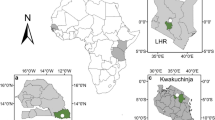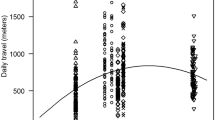Abstract
Group size influences foraging efficiency in several primates. We examined the activity budgets of 3 groups of Geoffroy's pied colobus (Colobus vellerosus) at the Boabeng-Fiema Monkey Sanctuary in Ghana to determine whether larger group size induces scramble competition. We studied 2 groups (B1; N = 7-8 and WW; N = 31-33) occupying slightly overlapping home ranges from August to November 2000. We observed the third group, B2 (N = 15-16), comprising B1 and 7 male invaders in the same home range as B1 from August to November 2001. By comparing groups belonging to the same population and occupying sligthly overlapping or similar home ranges, we were able to control, to a certain extent, for differences in food distribution. We recorded a total of 3353 scans, yielding 14,886 activity records, over 73 days. As with other black-and-white colobus, resting was their most common activity (59%). Intergroup comparisons suggest that time spent feeding, resting and moving did not vary in relation to group size. However, intragroup comparisons between the sexes show that females in the large group spent more time feeding than males did, whereas this was not the case in the small group, which suggests that scramble competition may be occurring among female Colobus vellerosus at BFMS. It is also possible that this may be due to greater nutritional requirements because of a higher proportion of infants in the large group. In fact, the proportion is quite similar between the two groups, lending support to the idea that females in the two groups had comparable nutritional demands due to lactation. This suggests that increased feeding in females in the large group was partly an effect of scramble competition. Group size and group composition also influenced the frequency of social behavior. There was more grooming in the large group, and it was performed mostly by females. The distribution of activities throughout the day was similar to the pattern reported for other black-and-white colobus.
Similar content being viewed by others
References
Alexander, R. D. (1974). The evolution of social behavior.Annu. Rev. Ecol. Syst. 5: 325-383.
Altmann, J., and Muruthi, P. (1988). Differences in daily life between semi-provisioned and wild-feeding baboons.Am. J. Primatol. 15: 213-221.
Bicca-Marques, J. C., and Calegaro-Marques, C. (1994). Activity budget and diet of Alouatta caraya: An age-sex analsysis. Folia Primatol. 63: 216-220. aiBocian, C. M. (1997). Niche Separation of Black-and-White Colobus Monkeys (Colobus angolensis and C. guereza) in the Ituri Forest, PhD Thesis, The City University of New York.
Chapman, C. A., and Chapman, L. J. (2000). Constraints on group size in red colobus and red-tailed guenons: Examining the generality of the Ecological Constraints Model.Int. J. Primatol. 21: 565-585.
Dasilva, G. L. (1992). The western black-and-white colobus as a low-energy strategist: Activity budgets, energy expenditure, and energy intake.J. Anim. Ecol. 61: 79-91.
Dasilva, G. L. (1993). Postural changes and behavioral thermoregulation in Colobus polykomos: The effect of climate and diet.Afr. J. Ecol. 31: 226-241.
Dasilva, G. L. (1994). Diet of Colobus polykomos on Tiwai Island: Selection of food in relation to its seasonal abundance and nutritional quality.Int. J. Primatol. 15: 655-680.
Davies, A. G., Oates, J. F., and Dasilva, G. L. (1999). Patterns of frugivory in three West African Colobine monkeys.Int. J. Primatol. 20: 327-357.
de Ruiter, J. R. (1986). The influence of group size on predator scanning and foraging behavior in wedge-capped capuchins.Behaviour 98: 240-258.
Dunbar, R. I. M. (1992). Time: A hidden constraint on the behavioral ecology of baboons.Behav. Ecol. Sociobiol. 31: 35-49.
Dunbar, R. I. M., and Dunbar, E. P. (1974). Ecology and population dynamics of Colobus guereza in Ethiopia.Folia Primatol. 21: 188-208.
Fargey, P. J. (1991). Assessment of the Conservation Status of the Boabeng-Fiema Monkey Sanctuary, Final Report to the Flora and Fauna Preservation Society, University of Science and Technology, Kumasi, Ghana.
Fashing, P. J. (2001a). Activity and ranging patterns of guerezas in the Kakamega forest: Intergroup variation and implications for intragroup feeding competition.Int. J. Primatol. 22: 549-577.
Fashing, P. J. (2001b). Male and female strategies during intergroup encounters in guerezas (Colobus guereza): Evidence for resource defense mediated through males and a comparison with other primates.Behav. Ecol. Sociobiol. 50: 219-230.
Fimbel, C., Vedder, A., Dierenfeld, E., and Mulindahabi, F. (2001). An ecological basis for large group size in Colobus angolesis in the Nyungwe Forest, Rwanda.Afr. J. Ecol. 39: 83-92.
Hawthorne, W. (1990). Field Guide to the Forest Trees of Ghana. Overseas Development Administration, Natural Resources Institute, Ghana.
Hemingway, C. A. (1999). Time budgets and foraging in a Malagasy primate: Do sex differences reflect reproductive condition and female dominance? Behav. Ecol. Sociobiol. 45: 311-322.
Isbell, L. A. (1991). Contest and scramble competition: Patterns of female aggression and ranging behavior among primates.Behav. Ecol. 2: 143-155.
Isbell, L. A., Pruetz, J. D., and Young, T. P. (1998). Movements of vervets (Cercopithecus aethiops) and patas monkeys (Erythrocebus patas) as estimators of food resource size, density, and distribution.Behav. Ecol. Sociobiol. 42: 123-133.
Isbell, L. A., and Young, T. P. (1993). Social and ecological influences on activity budgets vervet monkeys, and their implications for group living.Behav. Ecol. Sociobiol. 32: 377-385.
Iwamoto, T., and Dunbar, R. I. M. (1983). Thermoregulation, habitat quality, and the behavioral ecology of gelada baboons.J. Anim. Ecol. 52: 357-366.
Janson, C. H., and van Schaik, C. P. (1988). Reconizing the many faces of primate food competition: Methods.Behaviour 105: 165-186.
Kankam, B. O. (1997). The Population of Black-and-White Colobus (Colobus polykomos) and the Mona Monkeys (Cercopithecus mona) at the Boabeng-Fiema Monkey Sanctuary and Surrounding Villages, B.Sc. Thesis, University of Science and Technology, Kumasi, Ghana.
Korstjens, A. H., Sterck, E. H. M., and Noë, R. (2002). How adaptive or phylogenetically inert is primate social behaviour? A test with two sympatric colobines.Behaviour 139: 203-225.
Kurland, J. A., and Gaulin, S. J. C. (1979). Comparability among measures of primate diets.Primates 28: 71-77.
Marsh, C. W. (1981). Time budget of Tana river red colobus.Folia Primatol. 35: 30-50.
McKey, D. B., and Waterman, P. G. (1982). Ranging behavior of a group of black colobus (Colobus satanas) in the Douala-Edea Reserve, Cameroon.Folia Primatol. 39: 264-304.
Menon, S., and Poirier, F. E. (1996). Long-tailed macaques (Macaca silenus) in a disturbed forest fragment: Activity patterns and time budget.Int. J. Primatol. 17: 969-985.
Moreno-Black, G. S., and Bent, E. F. (1982). Secondary compounds in the diet of Colobus angolensis. Afr. J. Ecol. 20: 29-36.
Oates, J. F. (1977). The guereza and its food. In Clutton-Brock, T. H. (ed.), Primate Ecology: Studies of Feeding and Ranging Behaviour in Lemurs, Monkeys, and Apes, Academic Press, London, pp. 275-321.
Oates, J. F. (1994). The natural history of African colobines. In Davies, A. G., and Oates, J. F. (Eds.), Colobine Monkeys: Their Ecology, Behaviour, and Evolution, Cambridge University Press, Cambridge, UK, pp. 75-127.
Olson, D. K., and Curtin, S. (1984). The role of economic timber species in the ecology of black-and-white colobus and Diana monkeys in Bia National Park, Ghana.Int. J. Primatol. 5: 371.
Onderdonk, D. A., and Chapman, C. A. (2000). Coping with forest fragmentation: The primates of Kibale National Park, Uganda.Int. J. Primatol. 21: 587-611.
Rose, M. D. (1978). Feeding and associated positional behavior of black and white colobus monkeys (Colobus guereza). In Montgomery, G. G. (ed.), The Ecology of Arboreal Folivores, Smithsonian Institution Press, Washington, DC, pp. 253-262.
Saj, T. L., and Sicotte, P. (2002). Effect of male invasion and female transfer on social dynamics in Geoffroy's pied colobus (Colobus vellerosus), XIXth IPS Congress abstracts, Beijing, China.
Saj, T. L., and Sicotte, P. (in press). Species profile for Colobus vellerosus. In Kingdon, J., Happold, D., and Butynski, T. (Eds.), Mammals of Africa, Academic Press, London.
Saj, T. L., Teichroeb, J. A., MacIntosh, A. J., and Sicotte, P. (2002). Influence of between-group encounters on the ranging behavior of Geoffroy's pied colobus at the Boabeng-Fiema Monkey Sanctuary, Ghana.Am. J. Primatol. 57(Suppl. 1): 76.
Saj, T. L., Teichroeb, J. A., and Sicotte, P. (in review). The population status and habitat quality of the Geoffroy's pied colobus (Colobus vellerosus) at Boabeng-Fiema sacred grove, Ghana. In Paterson, J. D. (ed.), Conflict and Commensalism: The Human Primate Interface.
Schino, G., and Troisi, A. (1990). Behavioral thermoregulation in long-tailed macaques: Effects on social preference.Physiology Behav. 47: 1125-1128.
Schoener, T. W. (1971). Theory of feeding strategies.Annu. Rev. Ecol. Syst. 2: 369-404.
Stacey, P. B. (1986). Group size and foraging efficiency in yellow baboons.Behav. Ecol. Sociobiol. 18: 175-187.
Steenbeek, R., and van Schaik, C. P. (2001). Competition and group size in Thomas's langurs (Presbytis thomasi): The folivore paradox revisited.Behav. Ecol. Sociobiol. 49: 100-110.
Struhsaker, T. T. (1975). The Red Colobus Monkey, Chicago University Press: Chicago.
Struhsaker, T. T., and Leland, L. (1987). Colobines: Infanticide by adult males. In Smuts, B. B., Cheney, D. L., Seyfarth, R. M., Wrangham, R. W., and Struhsaker, T. T. (Eds.), Primate Societies, University of Chicago Press, Chicago, pp. 83-97.
Terborgh, J., and Janson, C. H. (1986). The socioecology of primate groups.Annu. Rev. Ecol. Syst. 17: 111-135.
van Schaik, C. P. (1983). Why are diurnal primates living in groups? Behaviour 87: 120-144.
van Schaik, C. P., van Noordwijk, M. A., de Boer, R. J., and den Tonkelaar, I. (1983). The effects of group size on time budgets and social behavior in wild long-tailed macaques.Behav. Ecol. Sociobiol. 13: 173-181.
Watts, D. (1988). Environmental influences on mountain gorilla activity budgets.Am. J. Primatol. 15: 195-211.
Williamson, D. K., and Dunbar, R. I. M. (1999). Energetics, time budgets and group size. In Lee, P. C. (ed.), Comparative Primate Socioecology, Cambridge University Press, Cambridge, UK, pp. 320-338.
Author information
Authors and Affiliations
Rights and permissions
About this article
Cite this article
Teichroeb, J.A., Saj, T.L., Paterson, J.D. et al. Effect of Group Size on Activity Budgets of Colobus vellerosus in Ghana. International Journal of Primatology 24, 743–758 (2003). https://doi.org/10.1023/A:1024672604524
Issue Date:
DOI: https://doi.org/10.1023/A:1024672604524




